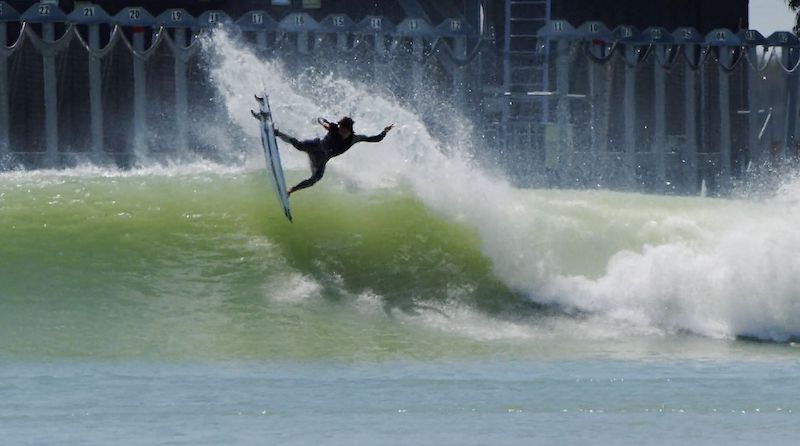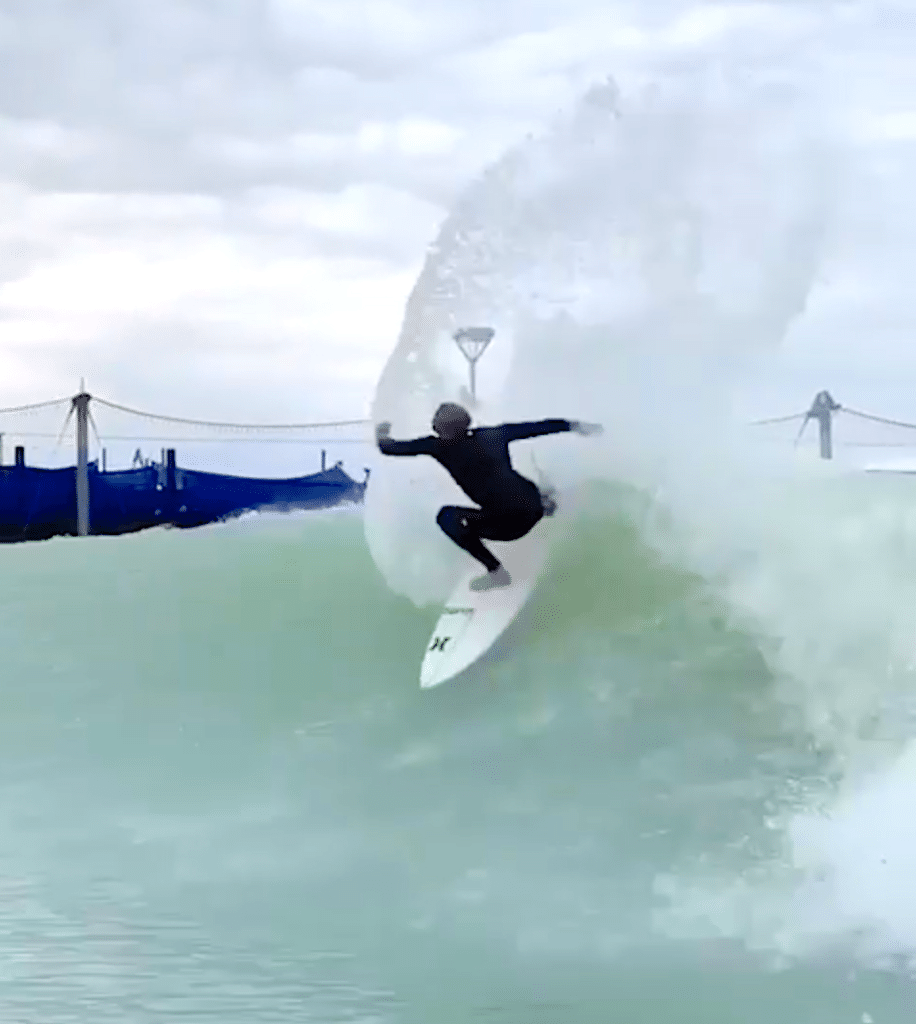Surf Ranch is "flat-faced like a bad skateboard ramp that you’d build when you were a kid," says shaper to the stars, Matt Biolos. And, therefore, you must build accordingly.
At September’s Surf Ranch Pro, held in Lemoore, California, a place where the dust settles into every case of skin like a new layer of pigment, Matt ‘Mayhem’ Biolos built surfboards for ten of the… what do we call ‘em now… oh yeah, athletes: Carissa Moore, Kolohe Andino, Yago Dora, Griffin Colapinto, Malia Manuel, Joan Duru, Michael Rodrigues, Caroline Marks, Coco Ho and Macy Callaghan.
It would’ve been eleven if the reigning champ Tyler Wright hadn’t called in sick.
Ain’t a shaper more invested in the pool game than Mayhem.
And as it happens, when I call Biolos for one of his grandfatherly sermons about design, he’s just walked in the door from a weekend in Waco, Texas.
It was Mason Ho’s thirtieth birthday and Lost threw the company credit card down for two private sessions, at $US2500 a roll, including a three-hour night hit.
Matt knows pools. He’s ridden most of ‘em: Wavegarden and Cove in the Basque Country, American Wave Machines in Waco, but not, surprisingly, the KSWaveCo version called Surf Ranch.
“I was invited, I probably shoulda gone,” he says.
Biolos isn’t blind to the wave.
“It has really tight transition, an unnatural transition, at the bottom so that as it grows taller it gets flat-faced like a bad skateboard ramp that you’d build when you were a kid. They put all the transition at the bottom and flat as it goes up the wall. But it’s weird. You don’t want a groveller. And you don’t want an epoxy, you don’t need an epoxy. You want a normal board that’s bit shorter to fit into that turn at the bottom.” MATT BIOLOS.
He made the four-hour north-east to Lemoore for the Founders’ Cup where he stood and watched for three days. And his teamriders had been sending him clips of their waves during their practice sessions prior to the Surf Ranch Pro.
So he’s thought about it.
“It’s powerful,” he says. “It has really tight transition, an unnatural transition, at the bottom so that as it grows taller it gets flat-faced like a bad skateboard ramp that you’d build when you were a kid. They put all the transition at the bottom and flat as it goes up the wall. But it’s weird. You don’t want a groveller. And you don’t want an epoxy, you don’t need an epoxy. You want a normal board that’s bit shorter to fit into that turn at the bottom.”
Curve-wise, Biolos gives ‘em a flat entry and a kick in the ass or vice-versa.
“You definitely need some curve. One end has to be curvy, the other straight.”
To specifics, Yago Dora, rode his usual volume, but an inch shorter.
Kolohe chose a one-inch shorter grovel board with a round tail. He wanted the control of the round tail without the drift and lift of a square.
Griff was happy taking his usual sled.
“Progress will happen shockingly fast. Like all these soccer parents teaching eight year olds to do technical airs in giant halfpipes on snowboards and skateboards. The static playing field will drive radically fast progression. This is an undeniable fact.” MATT BIOLOS
“The most consistent feedback was to use a high-performance board but an inch shorter. Not flat. Not lighter. Not wider. The shortness is just to fit into that kink at the bottom. But, it’s just starting. The relentless repetition will advance design quickly but how those quick advancements directed at specific waves translates to varied ocean waves remains to be seen. That said, one afternoon at Cove last year allowed Kolohe, Carissa, Griffin and grom Winter Vincent, and me, to quickly ride close to 50 waves each. Once you’re over the novelty and laughing and playing, you could easily get a lot of work done testing boards and fins. Progress will happen shockingly fast. Like all these soccer parents teaching eight year olds to do technical airs in giant halfpipes on snowboards and skateboards. The static playing field will drive radically fast progression. This is an undeniable fact.”Which would play into the leathery ol paws of Kelly Slater, you would think. He created Surf Ranch and there isn’t a surfer alive, despite what he says, that has ridden as many Surf Ranch waves.
Obviously a pool-specific hunk of space-age material, yeah?
Not even…close. It was a surfboard made by San Diego’s Dan Mann in 2015 and that sat in Kelly’s shed for two years until he loaned it to a pal who came back, breathless, and said, You have to ride this thing.
“The pool didn’t even exist,” when I shaped it, says Dan, who learned his craft at Rusty Surfboards after morphing from teamrider to shaper. “So it’s…definitely… not a pool specific board.”
The board is 5’9” x 18 3/8” x 2 3/8” with a “really pulled in thumb-tail” and “a real subtle spot behind the front fins,” says Dan, also responsible for ten or so of the designs in the Firewire range including the popular Baked Potato.
Thumb tail?
“A blunt round pin.”
Got it.
Carry on.
“He surfs it at the wave a lot. Founders’ Cup. Surf Ranch Pro,” says Dan. “He says, and this is my interpretation on his many different theories on why it works, is that he doesn’t have to think about it when it’s under his feet. And you can see that. On his second wave in the qualifying round, the right, he rips right into a turn after the first barrel section and the confidence that he goes into the turn with is obvious. He rode it in the first round at J-Bay in 2017 and you can see that he’s surfing without thinking about his board. If you watch him surf a lot you can see when he’s having fun and playing, the subtleties in between the turns. When he’s really grooving on a board, he’s grooving because he doesn’t need to think about it.”
Ât Slater Designs, they call the design the FRK. Officially it’s the Flipped Rocker Kelly, which is what Dan named the CAD file, but some are calling it the Freak or, after a wave or two, an Australian might call it…FaaaaaRK!
“The best thing about the pool event was how it isolated the skill and athleticism of the athlete,” says Dan.
The Gold Coast shaper Jason Stevenson had world number three Julian Wilson, Joel Parkinson, Ace Buchan, Mikey Wright, the wildcard Hiroto Ohara and Jeremy Flores under his marquee. The consensus among his riders was they wanted a little more curve and a shorter board on the hollower, faster right and something a little straighter for the unpredictable left.
Again, nothing radical.
The world number six, Jordy Smith whose ninth in the pool might’ve felt a little unjust given his unbelted approach, rode a Daniel Thomson-shaped Slater Designs Sci-Fi. Yeah, the same model Stu Kennedy rode to fantastic acclaim a few years back at the Quiksilver Pro.
Jordy’s was a 5’11” x 19 1/2” x 2 9/16”, which amounts to a generous thirty-three litres, and set up as a thruster. At the Founders’ Cup a few months earlier, Jordy had jumped on a stock Slater Designs Omni and dug the feel of the shorter board on the pool’s tight curves, especially on the left. He asked Tomo to make a few changes to the outline of it, turning the round-nose into something a little easier on the (traditional) eye.
Tomo shaped Jordy four boards for the Surf Ranch Pro. A 6’1 and 1/2” and a 5’11” Sci-Fi, a Cymatic and an Omni, both blunt-noses sharpened.
But it was the 5’11” Sci-Fi Jordy threw at the Surf Ranch Pro. No man’s going to risk an aesthetic prejudice when a world title is, possibly, in the offering.
And he chose the Sci-Fi because he was constantly landing his airs on it and believed the contest was going to come down to tech airs.
So if you want a conclusion about Pool Toys it’s this: they don’t exist. Yet.
“They’re paranoid about their athleticism and yet they have so much confidence,” says Dan Mann. “They’re more, ‘Give me a board I’m used to and I’ll work out the wave.’’
At the highest end, a pro surfer wants something he can set and forget and just think about the wave.
“Surfers are conservative,” says Biolos.
“They’re paranoid about their athleticism and yet they have so much confidence,” says Dan Mann. “They’re more, ‘Give me a board I’m used to and I’ll work out the wave.’’
A couple of hours after the Surf Ranch Pro finished, Kelly and Dan were texting back and forth, Kelly wanting to know how the FRK looked on the wave and how it could work better in general.
“The thing is, Kelly hadn’t given me any indication to change his regular board for the pool,” says Dan.
“Because that’s what he wanted in the pool. He wanted it to be a real wave.”
(Editor’s note: This story first appeared in an issue of Surfing Life magazine. It is reprinted here because, what, it’s Saturday, there’s a little south swell and who needs to be hitting the phones when one could be, ostensibly, hitting lips or reading one’s newest book, in this case Zorba the Greek, in the shade of a tree.)







